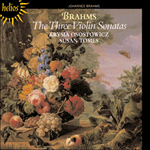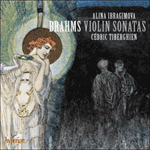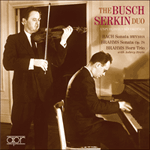
Welcome to Hyperion Records, a British classical label devoted to presenting high-quality recordings of music of all styles and from all periods from the twelfth century to the twenty-first.
Hyperion offers both CDs, and downloads in a number of formats. The site is also available in several languages.
Please use the dropdown buttons to set your preferred options, or use the checkbox to accept the defaults.

The opening movement’s main subject, unfolding quietly against sustained chords on the piano, arises out of the repeated-note rhythm that sets the song in motion. The subject has a smooth and flowing pendant in constant quaver motion which suggests that Brahms may have had at the back of his mind the mellifluous sound of Beethoven’s last violin sonata, Op 96, in the same key of G major.
The second subject is more forceful and animated, while a third idea beginning in the nature of a chorale becomes increasingly nervous as it proceeds. As he so often does, Brahms begins the development section with a return to the first subject in the home key, as though a varied repeat were about to commence, with the melody now given out by the piano to the background of pizzicato violin chords. But the flowing quavers soon lead the music in a new direction, and an elaborate development, almost entirely based around the main subject, gets under way. The recapitulation ends quietly and calmly, as though the music were about to die away into the distance; but a coda beginning in a mysterious pianissimo gradually gains in intensity, allowing the piece to come to a forceful conclusion.
The slow movement’s almost hymn-like theme is given out, sonorously harmonized, by the piano alone. With the entrance of the violin the music delves into darker realms that are explored at greater length in the middle section, which, despite its more flowing tempo, has the aspect of a funeral march whose repeated-note rhythm harks back to the beginning of the first movement. The reprise of the opening section is elaborately varied, with the melody now given out in double-stops by the violin, and the piano providing an intricate accompaniment. A coda echoes the middle section’s repeated-note rhythm while at the same time maintaining the music’s slow tempo.
In the finale, Brahms quotes the melancholy ‘Regenlied’ extensively, recalling not only the song’s melody but also its accompaniment in imitation of the patter of raindrops. At the centre of the piece stands an episode that harks back to the theme of the slow movement, thereby drawing the sonata’s threads still closer together. The same theme returns towards the end, enabling the music to dissolve from minor to major, and to die away peacefully. What may surprise us, however, is that Brahms should have chosen to write his finale in the minor in the first place. However, he had done the same in the case of his third symphony, while the B major piano trio, Op 8, goes so far as to come to a violent end with the music still firmly entrenched in the minor. The notion of providing a major-mode work with a finale setting off in the minor is one that Brahms may have learned from Haydn, two of whose late string quartets from Op 76 (one being the famous ‘Emperor’ Quartet) have a finale that follows the same procedure.
from notes by Misha Donat © 2019
Le sujet principal du premier mouvement, qui se déroule calmement sur des accords soutenus du piano, découle du rythme en notes répétées qui met le lied en mouvement. Le sujet a un pendant doux et fluide en mouvement constant de croches qui suggère que Brahms avait peut-être derrière la tête le son mélodieux de la dernière sonate pour violon et piano, op.96, de Beethoven, dans la même tonalité de sol majeur.
Le deuxième sujet est plus énergique et animé, alors qu’une troisième idée, qui tient tout d’abord d’un choral, devient de plus en plus tendue. Comme il le fait si souvent, Brahms entame le développement par un retour au premier sujet dans la tonalité initiale, comme si une reprise variée était sur le point de commencer, avec la mélodie jouée maintenant au piano sur un fond d’accords pizzicato du violon. Mais les croches fluides mènent bientôt la musique dans une nouvelle direction, avec le début d’un développement élaboré, presque entièrement basé sur le sujet principal. La réexposition s’achève calmement, comme si la musique allait s’éteindre dans le lointain; mais une coda débutant dans un mystérieux pianissimo prend peu à peu de l’intensité, ce qui permet au movement de parvenir à une énergique conclusion.
Le thème du mouvement lent, qui ressemble un peu à un hymne, est exposé par le piano seul, harmonisé de façon grandiloquente. Avec l’entrée du violon, la musique explore des royaumes plus sombres où l’on s’aventure plus longuement dans la section centrale: celle-ci, en dépit de son tempo plus fluide, a l’aspect d’une marche funèbre dont le rythme en notes répétées ressasse le début du premier mouvement. La reprise de la section initiale est variée minutieusement, la mélodie étant maintenant exposée en doubles cordes par le violon, avec un accompagnement complexe du piano. Une coda reprend le rythme en notes répétées de la section centrale, tout en conservant le tempo lent de la musique.
Dans le finale, Brahms cite longuement le «Regenlied» mélancolique, rappelant non seulement la mélodie du lied, mais également son accompagnement qui imite le crépitement des gouttes de pluie. Au centre du morceau se trouve un épisode qui revient sur le thème du mouvement lent, rassemblant encore davantage toutes les grandes lignes de cette sonate. Le même thème réapparaît à la fin, ce qui permet à la musique de se fondre du mineur au majeur et de s’éteindre paisiblement. Néanmoins, ce qui peut nous surprendre, c’est que Brahms ait choisi initialement d’écrire son finale en mineur. Mais il avait fait la même chose dans sa symphonie n° 3 en fa majeur, alors que le trio avec piano en si majeur, op.8, va jusqu’à en arriver à une fin violente tout en restant encore fermement enraciné en mineur. La notion consistant à écrire une œuvre en majeur avec un finale qui démarre en mineur est une idée que Brahms puisa peut-être chez Haydn, dont deux quatuors à cordes tardifs de l’op.76 (notamment le célèbre quatuor «L’Empereur») ont un finale qui suit le même cheminement.
extrait des notes rédigées par Misha Donat © 2019
Français: Marie-Stella Pâris
Das Hauptthema des ersten Satzes entfaltet sich leise über den ausgehaltenen Akkorden des Klaviers und erhebt sich aus dem Tonrepetitionsrhythmus, der das Lied in Bewegung setzt. Das Thema hat ein geschmeidiges und fließendes Anhängsel in konstanter Achtelbewegung, was darauf schließen lässt, dass Brahms möglicherweise den wohltönenden Klang der letzten Violinsonate von Beethoven, op. 96, ebenfalls in G-Dur, im Sinn hatte.
Das zweite Thema ist forscher und lebhafter, während ein drittes Motiv choralartig beginnt und dann zunehmend nervös wird. Wie so oft beginnt Brahms auch hier die Durchführung mit einer Rückkehr zum ersten Thema in der Grundtonart, als würde eine variierte Wiederholung anheben, in der die Melodie vom Klavier gespielt wird und im Hintergrund gezupfte Geigenakkorde erklingen. Doch lenken die fließenden Achtel die Musik schon bald in eine neue Richtung und dazu beginnt eine aufwendige Durchführung, die fast völlig auf dem Hauptthema basiert. Die Reprise endet ruhig und leise, als wolle die Musik in der Ferne ersterben, doch die in einem geheimnisvollen Pianissimo beginnende Coda wird allmählich intensiver, woraufhin das Stück zu einem kraftvollen Abschluss geführt wird.
Das fast hymnusartige Thema des langsamen Satz wird mit klangvoller Harmonisierung vom Klavier allein vorgestellt. Mit dem Einsatz der Geige taucht die Musik in dunklere Gefilde ab, welche im Mittelteil ausführlicher ausgelotet werden. Diese Passage mutet trotz ihres fließenden Tempos wie ein Trauermarsch an, dessen Tonrepetitionsrhythmus auf den ersten Satz zurückverweist. Die Reprise des Anfangsteils ist kunstvoll variiert, wobei die Melodie nun von der Geige in Doppelgriffen gespielt und feingliedrig vom Klavier begleitet wird. In der Coda taucht noch einmal der Tonrepetitionsrhythmus des Mittelteils auf, während das langsame Tempo der Musik allerdings beibehalten wird.
Im Finale bezieht Brahms sich mehrfach auf das melancholische „Regenlied“ und lässt nicht nur die Melodie erklingen, sondern auch die Regentropfen imitierende Begleitung. Im Mittelpunkt des Stücks steht eine Episode, die sich auf das Thema des langsamen Satzes zurückbezieht und damit die Fäden der Sonate noch enger zusammenzieht. Dasselbe Thema kehrt gegen Ende wieder, woraufhin die Musik von Moll nach Dur wechselt und sich dann friedlich auflöst. Es mag überraschen, dass Brahms sein Finale zunächst in Moll komponierte. Ebenso hatte er es jedoch bei seiner dritten Sinfonie (F-Dur) gehalten, während das Klaviertrio H-Dur, op. 8, zu einem heftigen Ende geführt wird, wobei die Musik noch fest in Moll verankert ist. Das Konzept, bei einem Werk in Dur das Finale in Moll beginnen zu lassen, hatte Brahms möglicherweise von Haydn übernommen, der sich in zwei seiner späten Streichquartette op. 76 (eines davon ist das berühmte „Kaiserquartett“) dieses Verfahrens bedient hatte.
aus dem Begleittext von Misha Donat © 2019
Deutsch: Viola Scheffel
 Brahms: The Three Violin Sonatas Brahms: The Three Violin Sonatas‘Subtle enough to suggest that for both artists these performances were a revelatory voyage of discovery’ (Gramophone) ‘Krysia Osostowicz and Susan Tomes have a wonderful naturalness about their playing; it is true chamber music’ (The Times)» More |
 Brahms: Violin Sonatas Brahms: Violin SonatasAnother important release from the pre-eminent duo of Alina Ibragimova and Cédric Tiberghien brings matchless accounts of Brahms’s three violin sonatas, with a Clara Schumann encore to conclude.» More |
 The Busch-Serkin Duo - Unpublished Recordings The Busch-Serkin Duo - Unpublished Recordings |

